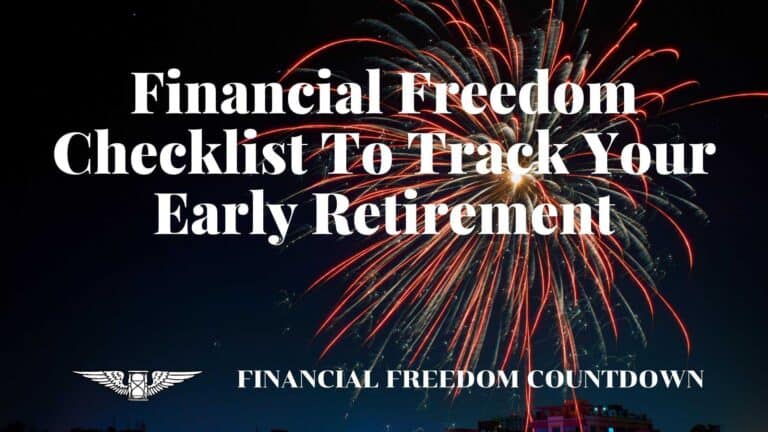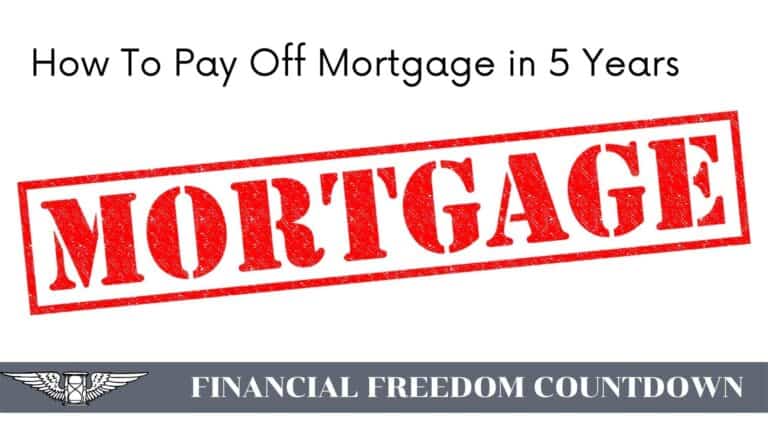Coast FIRE: The Easiest Financial Independence Route To Pursue

The traditional Financial Independence Retire Early (FIRE) movement is a relatively simple one to understand. In this model, individuals are expected to save 25 times their annual expenses in income-producing assets to retire as early as possible.
However, life is not always linear. There will be periods when your earning potential is the highest in the form of 7 figure jobs or side hustles.
Eventually, you want to slow down the hustle and enjoy life more. You might have extra dependents in the form of aging parents or kids. Or want to travel more instead of saving for retirement.
Coast FIRE is an alternative way to fill your retirement accounts and retire while incorporating flexibility in your retirement savings plan.
What Is Coast FIRE?
The Coast FIRE movement is geared around the idea that you can frontload retirement savings and stop contributing to retirement accounts. The money already invested in your retirement account will grow based on the principles of compound interest, permitting you to retire before the traditional retirement age.
This path to financial independence will allow you to retire at a time of your choosing, but it will also mean that you don’t have to make further contributions once you save enough money. Instead, you can enjoy spending the money you earn every year after the frontloading years are done.
How Does Coast FIRE Differ From Traditional FIRE?
The goal of traditional FIRE is to allow you to achieve financial freedom as early as possible. According to the basic principles of the 4 percent safe withdrawal rate rule of retirement, you can achieve financial independence based on your nest egg. Once you limit your annual expenses, you can put as much money into your retirement accounts as possible, which enables you to save enough money to retire when you want.
Coast FIRE is a slight offshoot of traditional FIRE. It involves a massive acceleration of your retirement contributions. In Coast Fire, you frontload your retirement contributions into 10-15 years of savings. From there, you can stop adding to your retirement account.
However, that’s not to say that you retire right there. Instead, you determine your coast FIRE number, meaning how much money you will need to retire by a specific date. From there, you let your retirement accounts grow, using investment gains and compound interest to add more and more to your nest egg. Once you have “coasted” long enough, you will reach your coast fire number and be able to retire before the traditional retirement age.
The main difference between traditional FIRE and Coast FIRE is how long you make the contributions. Under traditional FIRE, you make as many contributions to your retirement account as possible until you reach the age you can retire at an early age.
In Coast FIRE, you frontload those contributions, then stop by when you reach your pre-determined FIRE number, around your 30s or 40s. You continue working during this period but stop contributing to your retirement account, as you will have already hit Coast FIRE goals.
Of course, there is extensive overlap between traditional FIRE and Coast FIRE. Both require significant financial contributions and commitment to hit early retirement. In both situations, one has to be fiscally responsible and adhere to a budget.
Use free software like Personal Capital to examine your spending plan and categorize the information to create a budget. Compared to other apps, Personal Capital doesn’t need you to do the tedious task of manually entering all the information. After you link all your accounts together, it automatically combines all the transactions from every bank account, credit card, and financial institution so you can analyze how your money comes in and where you spend. You can read my Personal Capital Review and how I use the various components to set up your free account.
To hit Coast FIRE goals, you must accelerate those contributions. In both cases, the FIRE journey is difficult. It requires massive adjustments to your lifestyle and active management of your investment portfolio. Choosing between saving vs. investing, you need to shift your focus toward investing.
You will have to have more money invested in income-generating assets than others who don’t follow your financial path. Also, learning how to invest in stocks or real estatewould be best.
And limit your current expenses, manage your yearly costs in advance, and pay much more attention to your finances than others in a similar financial bracket.
Trim is an excellent service that looks at all your current subscriptions and saves money by eliminating unnecessary money leeches. Also, instead of paying full price, sign up and see if Trim can negotiate lower cable, phone, and internet bills.
Significant retirement contributions for Coast FIRE may also require income enhancements. You may reevaluate your financial goals, find a part-time job, or develop passive income streams to support your goals.
You can put in additional effort in the form of sweat equity by pursuing real estate investing with little or no money down.
Reaching an early retirement can be done, but it requires a significant commitment and intelligent investing to make it happen.
How To Calculate Your Coast FIRE Number?
Achieving the financial independence promised by Coast FIRE requires understanding your Coast FIRE number, which is much more complicated than a standard compound interest formula. There are many Coast FIRE numbers you have to understand:
- When will I have saved up a large enough nest egg to retire early?
- How much do I have to contribute to reaching my Coast FIRE number?
- What happens if the stock market does better than anticipated? Or worse than expected?
To meet your FIRE number, you have to multiply your annual expenses by 25. It should include living and significant costs, like health insurance, even if you have money saved up in your HSA.
FIRE nest egg = Annual Expenses x 25
Once you have your FIRE nest egg number, calculating your Coast FIRE formula is based on the rate of return your investments can generate and the amount of time you can leave the nest egg alone to compound.
Coast FIRE number = FIRE nest egg / (1 + Annual Rate of Return) ^ (number of years)
For example, if your expected annual expenses are $40,000 per year, your FIRE nest egg should be $40,000*25 = $1,000,000
The $1 million is your FIRE number.
Of course, you might need more time to accumulate $1 million in income-generating assets before retiring. Coast FIRE provides an intermediate milestone along the journey.
Let us assume our retirement accounts generate a 7% rate of return, and you plan to retire after 20 years.
Coast FIRE number = 1,000,000 / (1.07) ^ 20 = $258,419
Based on the Coast FIRE formula, if you accumulate $258,419 in your retirement accounts and don’t contribute anything after you reach that number, you can still retire after 20 years, assuming a 7% rate of return.
Remember that, like all rules of thumb; the Coast FIRE number is not exact. Making additional contributions to your retirement savings account may get you to a place where you can retire even earlier.
Furthermore, if your Coast FIRE number fails to materialize due to crashes in the stock market, you may have to alter your retirement plans.
As such, remember that this number – and this formula – is meant to serve as a rough guide, not a guaranteed investment and retirement age.
How Can I Use Coast FIRE To Retire Early?
The most important thing about Coast FIRE is that you understand the money you will need to contribute to meet the financial independence that Coast FIRE promises. The ability to reach Coast FIRE is not guaranteed, even with regular savings before you get your “coast” date. As such, you should consult with a certified financial planner who is an expert in Coast FIRE and understands how to help people reach this critical goal.
If you need help using Coast FIRE to accelerate your traditional retirement goals, you are lucky, as many resources can guide you. For example, you can easily use the Coast FIRE calculator provided above, which can help you understand what you need to contribute and how much you need to gain with your investments to achieve Coast FIRE.
Finally, as many experts in Coast FIRE will tell you, becoming financially independent with Coast FIRE is about much more than making regular contributions. It truly is a mindset. Coast FIRE requires significant financial sacrifice.
The Coast FIRE approach demands that you significantly reduce your annual expenses while pursuing financial independence. Traditional markers of financial success for a young individual, like buying a house or going on expensive vacations, will almost certainly be out of reach if you truly dedicate yourself to this approach.
The amount of money you have to contribute to your retirement will be massive. It will require extensive financial planning.
As such, the FIRE lifestyle isn’t for everyone. There is certainly nothing wrong with not choosing the Coast FIRE approach! However, if you prefer it, you must understand what you will sacrifice to strengthen your financial portfolio and reach financial independence.
What Are the Benefits of Coast FIRE?
Peace of Mind
The timing of this financial movement provides real advantages. Instead of making contributions for your entire adult life, you frontload your contributions. Once you reach your coast FIRE number, you no longer have to make massive contributions and can stop contributing to your retirement plan.
You can rest assured that even if you never contribute a single penny to your accounts, you can meet your retirement expenses and still enjoy the benefits of true FIRE.
Coast FIRE takes advantage of traditional and well-understood economic principles, such as compound interest, dividend returns, and investment gains.
Stepping Stone to Other FIRE Paths
While traditional FIRE or Fat FIRE may seem unattainable, Coast FIRE is possible for everyone.
Also, Coast FIRE can form the basis of other types of FIRE, such as Lean FIRE, Barista FIRE, Traditional, and Fat FIRE.
Blends With Life Changes
When you are younger, you have a lower number of dependents and can save money to hit the all-important goal of early retirement. Also, at an early age, you have the additional time and energy to pursue various types of income to accelerate your FIRE path before you are burdened with family responsibilities.
For example, you might have time to pursue flipping houses, wholesaling homes or even doing a live-in flip, such as the BRRRR method.
More Investment Options
After achieving Coast FIRE, you can free up money for investment in whatever you see fit. This means that you gain investment flexibility as you get older. Such a concept is very different from other financial movements, including many other types of FIRE plans which rely on investing in the S&P 500.
You can now invest in moonshot companies or even asymmetric bets such as investing in crypto.
Career Flexibility
Coast FIRE will also give you more flexibility with your career, which means you can make the career movements you need. You can switch jobs as you get older. Constantly leveraging your human capital to earn higher income brings stress. As you move into your 40s and beyond, you could pick a recession-proof job. These jobs will pay less, but the benefits are better work-life balance.
For many, retirement goals are a massive part of this calculation. If you switch jobs, do you lose your pension benefits? How will it impact your retirement plans? If you adhere to hitting your Coast FI number, this isn’t a worry: You’ll be able to retire at a time of your choosing and still pay for your current expenses.
Location Flexibility
High-paying jobs are typically in HCOL vs. LCOL. Coast FIRE provides the flexibility to no longer continue living in expensive cities. A slow-paced country lifestyle is possible as you join the exodus of states losing population. You could relocate to some of the best states for real estate investors and switch from turnkey property management to self-management.
What Are the Potential Drawbacks of Coast FIRE?
Coast FIRE has many benefits – if it goes right. However, there are serious risks involved with this particular approach.
Performance and Timing Risk
Chief among them is performance. Like any other retirement plan, it relies on an excellent stock market performance to achieve your Coast FIRE number.
If the stock market enters a bear market or anything unexpected happens, such as a recession, you might have less money than you planned.
Diversification Risk
The risk is compounded by the fact that you stop making contributions to your account sometime in your 30s or 40s. As such, you rely entirely on compound interest and other investment gains to pay your living expenses in retirement.
One of the advantages of contributing to your retirement accounts over several decades is dollar cost averaging or diversification over time.
The lack of contributions may mean that you need to tweak your retirement portfolio in a different direction. Meeting your Coast FIRE number and dealing with normal pressures – like inflation – may require altering your retirement account makeup and taking more risks.
While this can pay off, it is also a hazardous strategy. If anything goes wrong in your portfolio, you may face additional financial pressure and discover the need to contribute more money to meet your retirement goals.
Lifestyle Changes
It’s also important to realize that achieving Coast FIRE means significant changes to your lifestyle. Hitting your Coast FIRE goals and becoming financially independent as you are older means making substantial contributions to your retirement account at a young age. Compared to your peers who will be spending money, you will need to sacrifice for a goal decades away.
Harder To Stop Lifestyle Inflation
Coast FIRE involves saving at an early age and then no longer saving. Consequently, one may fall into a lifestyle inflation trap by spending their entire paycheck every month. Since the financial independence retire early movement is based on saving a multiple of your annual expenses, lifestyle inflation can make it harder to achieve.
Should You Pursue Coast FIRE?
If you plan to pursue financial independence, coast fire can be considered the ultimate goal or a stepping stone to other FIRE methods.
After you reach your Coast FIRE number, you can decide what FIRE lifestyle you want to pursue.
Coast FIRE vs. Lean FIRE
Lean FIRE involves early retirement as long as your basic necessities are met based on your current and future spending patterns. After achieving Coast financial independence, you can decide if you want to continue aggressively saving for a few more years till you have enough money to Lean FIRE.
Coast FIRE vs. Traditional FIRE
Traditional FIRE is similar to Lean FIRE, except your budget involves a few luxuries, and you save 25 times your expected annual expenses. Instead of stopping at Coast FIRE, you can press onwards until you reach your Traditional FIRE number. In the example above, it would be $1 Million.
Coast FIRE vs. Barista FIRE
Barista FIRE requires that people keep a part-time job to generate income and obtain health insurance. Typically Barista FIRE still involves some level of work, even if it is a low-stress retirement job.
Coast FIRE completely frees you from the need to hold any part-time or full-time employment, allowing you to achieve total flexibility. For some, the idea of a complete retirement – where there is no need to work- can be intimidating. Loss of all social contact is one of the aspects which should be considered for timing when to retire.
As such, Barista FIRE may provide an excellent middle ground. However, if you can hit your Coast FIRE goals, Barista FIRE isn’t necessary.
Coast FIRE vs. Fat FIRE
Fat FIRE involves several discretionary items, and you save 33 times your expected annual expenses. Instead of stopping at Coast FIRE, you can continue till you reach your fat FIRE number. In the example above, it would be $1.32 Million.
By now, you should understand the positives and the negatives of Coast financial independence. If you genuinely want to be financially independent, you can. It is up to you to determine which FIRE subset best fits your lifestyle and goals.
Most important is understanding which FIRE movement works for you, setting annual goals, and developing the discipline to meet these goals.

John Dealbreuin came from a third world country to the US with only $1,000 not knowing anyone; guided by an immigrant dream. In 12 years, he achieved his retirement number.
He started Financial Freedom Countdown to help everyone think differently about their financial challenges and live their best lives. John resides in the San Francisco Bay Area enjoying nature trails and weight training.
Here are his recommended tools
M1 Finance: John compared M1 Finance against Vanguard, Schwab, Fidelity, Wealthfront and Betterment to find the perfect investment platform. He uses it due to zero fees, very low minimums, automated investment with automatic rebalancing. The pre-built asset allocations and fractional shares helps one get started right away.
Personal Capital: This is a free tool John uses to track his net worth on a regular basis and as a retirement planner. It also alerts him wrt hidden fees and has a budget tracker included.
Streitwise is available for accredited and non-accredited investors. They have one of the lowest fees and high “skin in the game,” with over $5M of capital invested by founders in the deals. It is also open to foreign/non-USA investor. Minimum investment is $5,000.
Platforms like Yieldstreet provide investment options in art, legal, structured notes, venture capital, etc. They also have fixed-income portfolios spread across multiple asset classes with a single investment with low minimums of $10,000.






